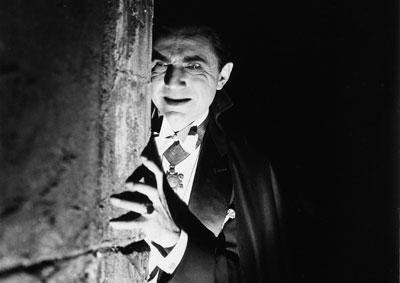Directed by Tod Browning
Billed as a Gothic romance, the overnight success that met “the story of the strangest passion the world has ever known” helped launch a series of iconic horror films at Universal, giving the studio not only a steady financial boost at the dawn of the sound era but also a new identity, one it would be associated with for decades to come.
Based on Bram Stoker’s novel and a wildly successful stage adaptation by Hamilton Deane and John L. Balderston, Tod Browning’s realization bears the influence of both. While the film’s compositions have been characterized as betraying the source material’s theatrical origins (perhaps attributable to the new encumbrances of sound equipment), Karl Freund’s moody and atmospheric photography, particularly in the gloomy interiors of Dracula’s decaying castle, adeptly displays the cinematic influence of German Expressionism and Murnau’s Nosferatu (1922). One of the earliest sound horror films, Dracula eschewed a musical score for the most part, the better to accentuate every creak, footstep, and wolf howl against an ominous silence.
The piercing gaze and deliberate delivery of Bela Lugosi, the Hungarian actor who had played the Count in the American stage version, lent an eerie presence to the role and became the standard by which the many future incarnations of Dracula would be judged. Ironically, though Lugosi would come to be associated with the hypnotic bloodsucker for the rest of his life—he was even buried wearing Dracula’s cape—he was Browning’s last choice for the role. The director preferred Lon Chaney Sr. who died of throat cancer before production could begin. When other prospects proved unavailable or unsuitable, Lugosi was offered the role for a pittance, later reprising it in such films as Mark of the Vampire (1935), Return of the Vampire (1944), and Abbott and Costello Meet Frankenstein (1948).
Asked in a 1952 interview if Dracula ever ends for him, Lugosi replied, “No, no; Dracula never ends. I don’t know whether I should call it a fortune or a curse, but it never ends.” A milestone for the genre and for Universal, Dracula and Bela Lugosi’s portrayal of the sinister, otherworldly Count resonate to this day.
—Nina Rao
Universal Pictures. Producer: Carl Laemmle Jr. Based on the novel by Bram Stoker. Screenwriter: Garrett Fort. Cinematographer: Karl Freund. Editor: Milton Carruth. Cast: Bela Lugosi, Helen Chandler, David Manners, Dwight Frye, Edward Van Sloan.
35mm, b/w, 75 min.






 Mobile Navigation
Mobile Navigation

